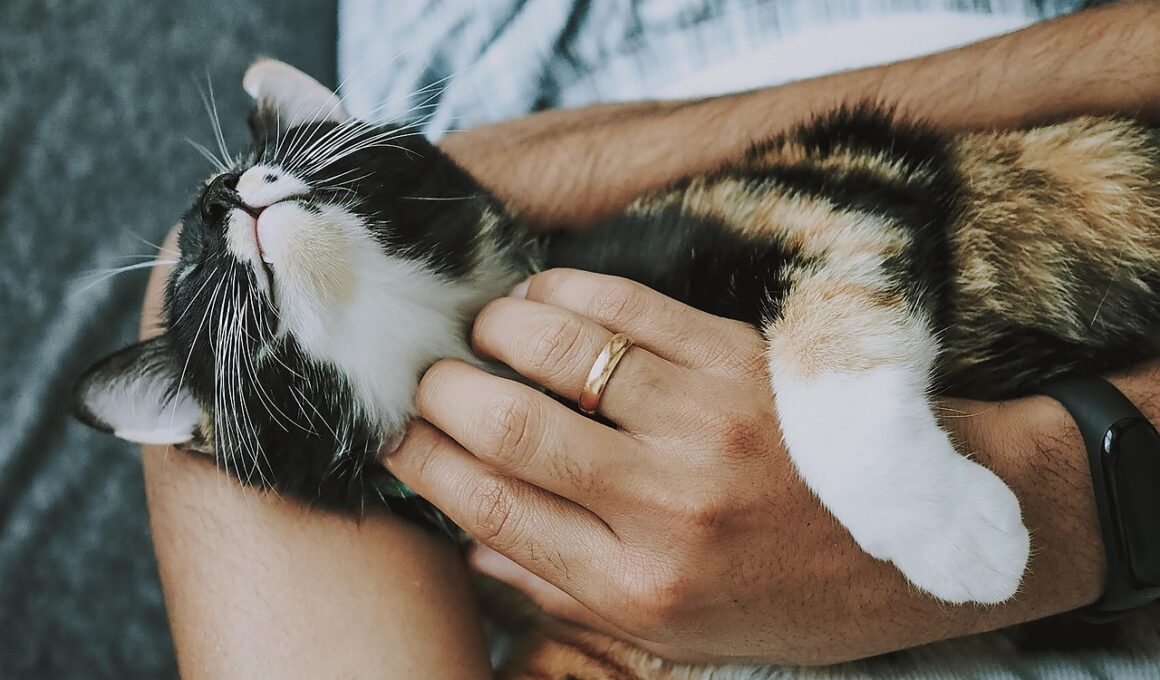Medications for Managing Oral Pain in Cats: What You Should Know
Oral pain in cats can be a serious issue that impacts their overall health and quality of life. A variety of medications are available to manage this pain, often prescribed by veterinarians based on specific needs. Non-steroidal anti-inflammatory drugs (NSAIDs) are commonly recommended to reduce inflammation and alleviate discomfort. These medications work by blocking enzymes associated with inflammation. Gabapentin is another option, which primarily targets neuropathic pain in cats. It can be helpful for cats suffering from dental pain, especially when other medications are insufficient. While these drugs have benefits, monitoring your cat for potential side effects is crucial. Side effects might include vomiting or changes in appetite. Excellence in pain management not only addresses the immediate discomfort but also contributes to a cat’s emotional well-being. Operating under a veterinary prescription is essential, as dosages vary based on a cat’s size, age, and medical history. Always consult your vet before initiating medication. Furthermore, incorporating proper dental hygiene can enhance the effectiveness of pain management strategies. Regular check-ups help in early detection and abstaining from further pain-related issues.
In addition to NSAIDs and gabapentin, there are other medications that might be used to alleviate oral pain. Opioids can be prescribed for more severe or chronic cases of pain. They provide powerful pain relief but should be used cautiously due to potential for dependency and side effects, which may include sedation. Buprenorphine is a commonly prescribed opioid that can be effective in managing moderate to severe pain. However, its use requires careful monitoring by a veterinarian. On the other hand, Corticosteroids could be useful in reducing inflammation linked to oral conditions, such as gingivitis or stomatitis. Utilizing a combination of these medications under veterinary guidance can offer the best pain management strategy for cats. Some cat owners may consider over-the-counter alternatives like herbal or homeopathic remedies. These should only be used after consulting a veterinarian, as not all products are safe or effective. Understanding the range of options available is vital for enabling informed discussions with your vet. Keeping abreast of the latest developments in veterinary pain management is important for achieving the best results for your furry friend.
Understanding Side Effects and Risks
When managing oral pain in cats with medications, it is essential to be aware of potential side effects and risks associated with each treatment option. Pain relief drugs can come with various adverse reactions, and recognizing these can aid in prompt veterinary intervention. For instance, NSAIDs might lead to gastrointestinal upset or kidney issues if misused or used over long periods. Consequently, appropriate dosing according to your vet’s recommendations is crucial. Additionally, regular monitoring of organ function might be necessary to ensure your cat’s safety. Opioid-based medications can cause sedation and changes in behavior, which may go unnoticed in less observant cat owners. Signs of adverse reactions often appear quickly after medication initiation and warrant immediate attention. Moreover, it’s important to avoid abruptly discontinuing medication, especially opioids, as this can lead to withdrawal symptoms affecting your cat’s health. Establishing a consistent routine for administering pain relief medications while keeping an open line of communication with your veterinarian is integral to safeguarding your cat’s health. Ultimately, balancing pain management while minimizing side effects can significantly enhance your cat’s quality of life.
A crucial component of managing oral pain in cats is determining the underlying cause effectively. Many cats suffer from various dental issues, such as periodontal disease or oral tumors, which require specific treatment plans. Identifying these will help your veterinarian recommend the most appropriate type of medication or intervention. Dental evaluations should be part of regular health examinations for cats, as early detection of oral diseases leads to better prognosis. Additionally, regular cleanings under anesthesia may be necessary in severe cases. Once the underlying problem is addressed, medications can then play a supporting role in pain management. In acute situations, medications may be prescribed directly related to surgical procedures or oral treatments. Preventive measures should also not be overlooked, as implementing good dental care practices can significantly reduce the incidence of painful conditions. Options may include daily dental care, enzymatic toothpaste, or dental treats. These preventative measures can also enhance the effectiveness of prescribed medications by contributing to overall oral health. Consequently, maintaining a proactive approach to dental health is vital in assuring a better quality of life for your beloved feline companion.
Incorporating Non-Medication Strategies
Aside from medication, integrating non-medication strategies can play a pivotal role in managing oral pain in cats. Simple adjustments to their environment or care routine can significantly impact their comfort levels. Regular dental care practices, such as brushing their teeth and providing dental chews, can greatly improve oral health. These proactive steps reduce the buildup of plaque and tartar, consequently minimizing the chances of dental disease. Additionally, maintaining appropriate nutrition can aid in oral health; high-quality, dental-formulated diets are available. Addressing stress and anxiety is also crucial, as stress can exacerbate pain symptoms. Creating a calming environment using soft bedding, quiet spaces, and gentle interactions can help manage discomfort. It’s also imperative to observe your cat’s behavior closely, as changes in eating habits or play can signal that something is wrong. If your cat seems in distress, do not hesitate to consult with your veterinarian to explore further pain management options. Furthermore, engaging your cat in less strenuous activities can help maintain a positive emotional state while coping with pain. It is essential to keep a well-rounded approach to maximize your cat’s overall wellbeing.
Monitoring your cat’s response to pain medications is a continuous responsibility that every owner should prioritize. Every cat may respond differently to the same medication, and what works for one may not be effective for another. Keeping a journal of your cat’s behavior, appetite, and any adverse reactions you observe can be incredibly beneficial for discussions with your veterinarian. Ensure you’re tracking changes closely, as this data can assist your vet in making informed adjustments to your cat’s pain management plan. If you notice improvements, celebrate these achievements as signs of a successful strategy. Likewise, if you observe any sudden changes, whether in activity or disposition, promptly contacting your veterinarian is necessary. Communication with your veterinarian also aids in developing a tailored approach consider various evaluation and treatment alternatives over time. Frequent check-ups are essential for those undergoing long-term medication. Ultimately, knowing your cat’s habits and preferences can empower your efforts toward effective pain management. The combination of monitoring, medication, and non-medication strategies can ensure that your cat enjoys a healthy, comfortable life, free from pain.
Conclusion: Finding the Right Balance
Finding the right balance between medication and holistic approaches to manage oral pain in cats is crucial for optimal health outcomes. Collaborating with your veterinarian ensures that your cat receives the most effective and safest treatment available. The veterinarian can help develop a comprehensive plan tailored to your cat’s specific needs. This plan might incorporate medication, dietary recommendations, and additional therapies that suit your cat’s condition. Each cat is unique, meaning their pain management regime must be crafted specifically for their circumstances. Remember, pain management is not a one-size-fits-all solution; staying informed about emerging treatments is essential. Regular consultations with your veterinarian, continuous monitoring of your cat’s health, and adjusting approaches as necessary are integral components. Paying attention to both behavioral and physiological signs in your cat can aid in understanding how they are coping with pain. Building a relationship with your veterinarian fosters trust and communication, ultimately leading to a more enjoyable life for your feline friend. By prioritizing pain management and making informed choices, you can help ensure your cat’s well-being today and in the future.
New Medications on the Horizon
New developments in the field of veterinary medicine offer exciting hope when it comes to managing oral pain in cats. As that research progresses, novel pain management options may become available. Current studies are exploring alternatives like potassium channels blockers and other nerve-targeting medications that could offer pain relief while minimizing side effects. Furthermore, regenerating therapies that involve stem cells are being examined for their potential healing effects on damaged oral tissues. These innovative treatments might lead to effective, long-last pain relief and improved healing for conditions that affect the mouth and gums. As promising as these developments sound, always check with your veterinarian about the appropriateness of new therapies for your cat. Another area gaining attention involves the use of cannabidiol (CBD) products for pain management. While anecdotal evidence exists suggesting the effectiveness of CBD, comprehensive research still is needed to fully understand its benefits and risks for cats. Veterinarians can best guide you toward safe, effective options tailored specifically to your feline companion. Remaining well-informed about advancements is crucial for making the best decisions for your pet’s oral health.





